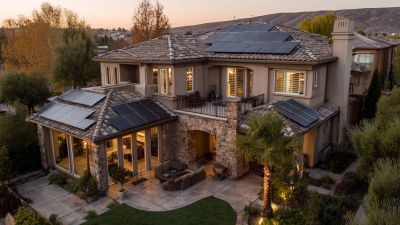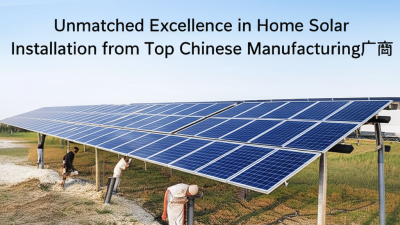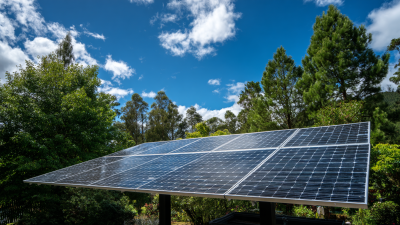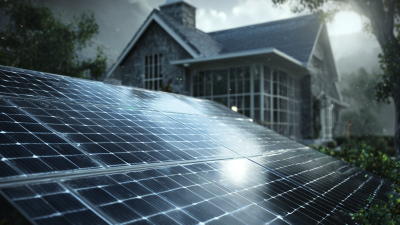Harnessing Savings: The Advantages of Cost-Efficient Solar Panel Installation
In recent years, the cost of solar panel installation has seen a remarkable decline, making renewable energy more accessible than ever. According to the International Renewable Energy Agency (IRENA), the global average price of solar photovoltaic (PV) systems dropped by over 80% between 2010 and 2020, paving the way for significant savings for homeowners and businesses alike. Furthermore, a report from Lazard states that the levelized cost of electricity (LCOE) for utility-scale solar projects is now competitive with traditional fossil fuels, solidifying solar energy's position as a viable alternative. As consumers increasingly recognize the long-term financial benefits and environmental advantages of switching to solar, harnessing savings from cost-efficient solar panel installation is not just a trend; it is an essential step towards sustainable living and energy independence.

Understanding the Basics of Cost-Efficient Solar Panel Installation
Cost-efficient solar panel installation is more than just a trend; it's a critical move for homeowners and businesses looking to reduce energy costs while making an environmentally friendly choice. According to the U.S. Department of Energy, the cost of solar panels has decreased by 80% since 2010, making them more accessible than ever. This significant reduction not only promotes sustainability but also allows consumers to recoup their investments quickly through reduced energy bills.
When considering solar installation, it's essential to focus on quality and efficiency. Selecting the right solar panels can impact long-term performance. Look for panels with a high efficiency rating—typically above 20%—and those that come with a substantial warranty, ideally 25 years. Data from the National Renewable Energy Laboratory indicates that well-chosen solar systems can produce significant savings, with average users saving between $10,000 to $30,000 over the lifespan of their systems.
**Tips**:
1. Explore financing options like leases or power purchase agreements (PPAs) to lower upfront costs.
2. Schedule a consultation with multiple solar providers to compare installation quotes and warranties.
3. Consider local and state incentives, as many regions offer tax credits or rebates that can enhance your savings.
Harnessing Savings: The Advantages of Cost-Efficient Solar Panel Installation
This chart illustrates the estimated savings on electricity bills over a period of 5 years for homeowners who have opted for cost-efficient solar panel installations. The data shows a steady increase in savings, demonstrating the financial benefits of solar energy.
Essential Factors to Consider Before Installing Solar Panels
Before installing solar panels, there are several essential factors that homeowners should consider to ensure cost efficiency and long-term benefits. One of the primary factors is the orientation and angle of your roof. Solar panels need to be installed at specific angles to capture maximum sunlight throughout the day. South-facing roofs tend to yield the best results, so assessing your home’s positioning and roof structure can significantly influence both energy production and installation costs.

Another critical aspect is the quality and type of solar panels you choose. While it may be tempting to opt for the cheapest available option, investing in high-quality panels can yield better efficiency and longer lifespans, ultimately saving money over time. Additionally, homeowners should research local incentives, rebates, and financing options available for solar installation. These can greatly offset initial expenses and enhance the overall financial viability of the project. By carefully evaluating these factors, homeowners can harness the advantages of solar energy while maximizing their savings.
How to Evaluate and Choose the Right Solar Installation Company
 When choosing a solar installation company, there are several key qualities to consider. Firstly, experience and reputation are critical indicators of a company’s reliability. Look for installers who have a proven track record and positive customer reviews. A company that has been in the industry for a while is likely to have the expertise to handle various installation scenarios.
When choosing a solar installation company, there are several key qualities to consider. Firstly, experience and reputation are critical indicators of a company’s reliability. Look for installers who have a proven track record and positive customer reviews. A company that has been in the industry for a while is likely to have the expertise to handle various installation scenarios.
Secondly, it’s essential to evaluate the range of services offered. Some companies may provide only installation, while others offer comprehensive packages that include maintenance and monitoring services. This can provide added convenience and assurance for your solar investment. Additionally, make sure to check if they source high-quality materials and offer warranties on both products and installation, as this reflects their commitment to quality.
Lastly, consider obtaining multiple quotes and comparing them, not just in terms of price but also the overall value of the services provided. Transparency in pricing and a willingness to answer questions can indicate a trustworthy installer. To find the best solar companies in Canberra, local directories and online forums can be invaluable resources, offering insights into customer experiences and expert recommendations.
Tips for Maximizing Savings Through Government Incentives and Rebates
When considering solar panel installation, one of the most effective ways to maximize your savings is by taking advantage of government incentives and rebates. Many state and federal programs offer significant financial assistance for homeowners who choose to invest in renewable energy. These can include tax credits, cash rebates, and even grants that substantially reduce the overall cost of installation.
For instance, the Federal Investment Tax Credit (ITC) allows homeowners to deduct a percentage of the solar installation cost from their federal taxes, providing a substantial financial relief that can influence your decision to go solar.
Additionally, local governments often provide their own incentives to encourage renewable energy adoption. It’s essential to research your local policies, as some areas have unique programs that offer direct financial benefits or performance-based incentives. Some utility companies may also have net metering policies that allow homeowners to sell excess electricity back to the grid, further enhancing your savings.
By thoroughly investigating and utilizing these financial incentives, homeowners can significantly lower their solar panel installation costs and enjoy the long-term benefits of sustainable energy without straining their budgets.
Maintaining Solar Panels for Long-Term Cost Efficiency
Maintaining solar panels is crucial for ensuring long-term cost efficiency and maximizing return on investment. Routine maintenance can help ensure that solar systems operate at peak performance, translating into substantial savings over time. According to a report by the National Renewable Energy Laboratory (NREL), properly maintained solar panels can increase energy production by up to 30%. This boost in efficiency not only enhances energy yield but also minimizes the overall cost per watt of electricity generated.
Regular cleaning, inspection, and timely repairs are essential components of solar panel maintenance. On average, homeowners can expect to spend between $150 and $300 annually on maintenance, which can seem modest compared to the potential savings. The Solar Energy Industries Association (SEIA) indicates that homeowners can save between $10,000 to $30,000 over 20 years by investing in solar energy, and maintaining those panels effectively can amplify those savings significantly. By addressing issues like debris accumulation or equipment malfunctions early on, users can prevent costly repairs and ensure their solar investment remains profitable for years to come.
Related Posts
-

The Future of Sustainable Living with the Best Home Solar Panel System
-

7 Essential Tips for Maximizing Efficiency with Sunlight Solar Solutions
-

Unmatched Excellence in Home Solar Installation from Top Chinese Manufacturing厂商
-

A Comprehensive Guide to Choosing the Best Residential Solar Panels for Your Home
-

7 Best Solar Panels for Maximum Efficiency in 2023
-

Ultimate Guide to Choosing the Best Solar Energy Panels for Your Home